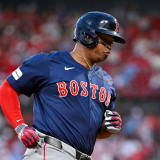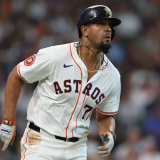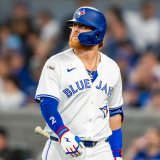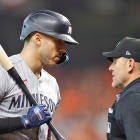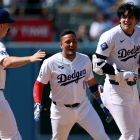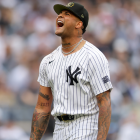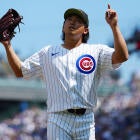
There will not be a minor-league season in 2020, yet there will be Prospect Watch -- albeit in an altered format. Rather than surveying the land for every team, we'll be highlighting one youngster playing in big-league games. This week, that player is New York Mets infielder Andres Gimenez, who has hit .293/.344/.402 (107 OPS+) in his first 90 plate appearances, and who has recently taken over at shortstop as manager Luis Rojas rides the hot hand.
Gimenez's success at the plate, even in a small sample size, registers as a surprise. Gimenez, who turned 22 last week, was young for Double-A last season, but he struggled on his way to a sub-.700 OPS. The combination of his walk-adverse approach and limited power output has long concerned talent evaluators on the ground that it will suppress his potential to hit for average -- big-league pitchers are the world's most effective bullies, and will pound the zone against perceived non-threats.
That hasn't been the case so far, though it's unclear that Gimenez will be able to maintain this level of production. His exit velocity (87.4 mph) and launch angle (13.6 degrees) are similar to a group that includes Freddy Galvis, Enrique Hernandez, and, oddly enough, Paul Goldschmidt. Goldschmidt is the only non-Gimenez member of that group with an OPS+ over 85, and his success can likely be credited to an ability to barrel the ball more frequently than the others.
Gimenez's approach has heretofore centered on hitting fastballs (14 of his 22 knocks) and pulling the ball, often on the ground. He has above-average speed, landing in the 93rd percentile in sprint speed, so it's reasonable to think he'll continue to beat out grounders that force the second baseman deep to their left or right.
The main worries about his game remain in place. He isn't walking or bopping, and he's not hitting the ball hard enough to envision his high average remaining. It's possible he makes gains as he matures and becomes accustomed to high-level pitching; it's just hard to foresee him being more than a bottom-third hitter.
Still, Gimenez is likely to have a lengthy big-league career because of his plus defense. He has an innate feel for the position, along with all the necessary physical attributes to be an asset at the six. That includes good range and a strong enough arm to convert tougher fielding chances.
Perhaps the best way to sum up Gimenez's future prospects is that his bat will determine his ceiling while his glove dictates his floor. There should be a spot for him in the big leagues, and probably in someone's lineup, regardless.










